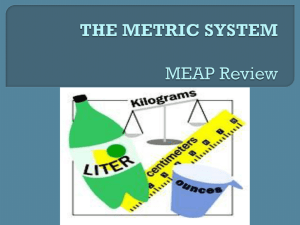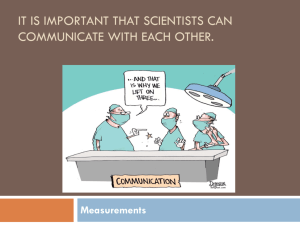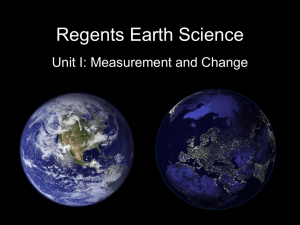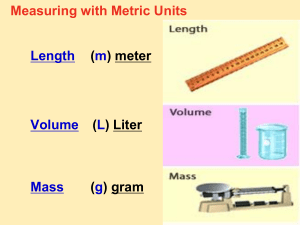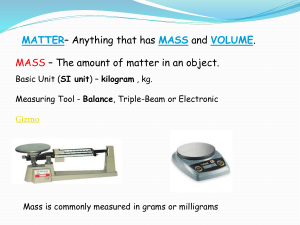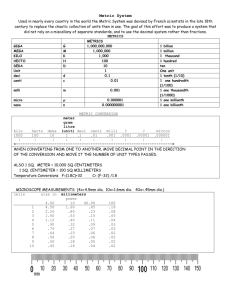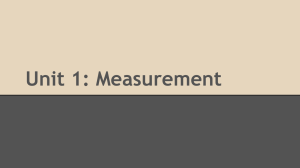International System of Measurement
advertisement
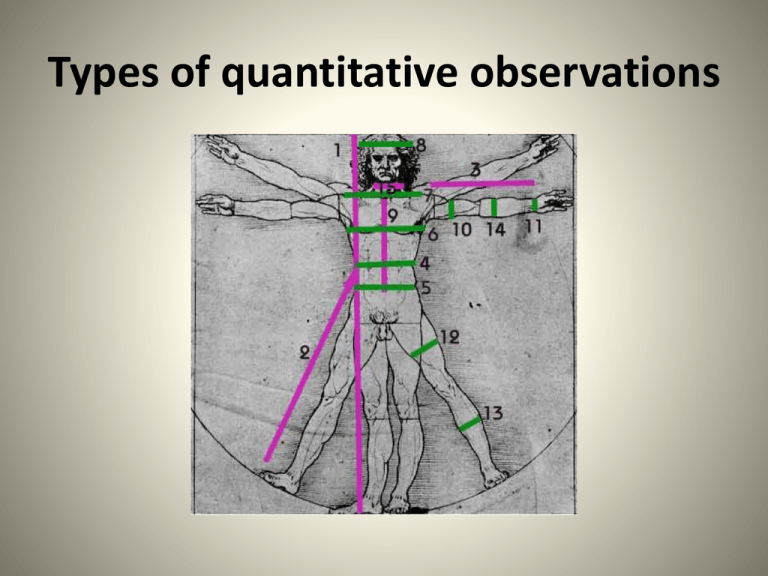
Types of quantitative observations International System of Units • 1. Known as SI units (System International) – Official name of the metric system. – Is an “universal system of measurement” in the scientific world. – What does “Universal” mean? • Used by all scientist worldwide regardless of their language. • Why does science need an universal system of measurement? (think of the scientific method) – Step 6 of the scientific method – Results of an experiment must be able to be replicated by other scientist 2. The metric/SI system is also easier to use. – Why? – The system is based on or of 10 – You only need to move a decimal point to the left or to the right. Length: distance between 2 points SI base unit = meter Instrument used to measure length? metric ruler or meter stick Divisions of a meter = dm, cm, mm Multiples of a meter = Km, Hm, Dm Let’s practice!!!!!!! • Answers: 1. Measure the length of this rectangle in centimeters: 2. Measure the height of this rectangle in centimeters: Height Length 3. Measure the length of this line in millimeters: Conversions -Changing from one unit to another. -Uses prefixes to describe divisions and multiples of a base unit. 1000 100 10 1 .1 .01 .001 Kilo Hecto Deca BASE deci centi milli UNIT King Henry died----gulp----drinking chocolate milk Metric –vs- English Conversions Kilo Hecto Deca BASE deci centi milli UNIT Easier: 10 Kilometers = how many meters? 500 centimeters = how many meters? Harder: 10 miles = how many inches? AREA • What is the area of an object? • L x W = meters squared 5 cm = 50 cm2 10 cm Temperature SI base unit = degrees Celsius Instrument used to measure: Thermometer Therm = heat Let’s do a comparison: CELSIUS 100 -------37 -------22 ------0 -------- VS FAHRENHEIT WATER BOILS BODY TEMP ROOM TEMP WATER FREEZES ° C x 9/5 + 32 = °F (°F - 32) x 5/9 = °C 212 ---------98.6 ---------70 32 ---------- BOILING 37 C 22 BODY TEMP ROOM TEMP FREEZING 98.6 C Volume • How much space an object occupies. • Two types of volume: Liquid and solid • Liquid volume: SI base unit = liter (Kl, Hl, Dl, l, dl, cl, ml) Instrument used to measure liquid volume? Graduated Cylinder Flask Graduated Cylinder Beaker • Solid Volume: Amount of space an object occupies. Length x Width x Height SI label: m3 or cm3 Not all solids have a regular shape!! Sometimes the length , width and height can not be determined Regularly shaped Irregularly shaped • Solid volume of a irregular shaped object – Use water displacement to determine volume Water Displacement Record volume of water in graduated cylinder. 7ml Add object Record volume of water after object is added. 9ml The difference is the volume of the object Change unit to cm3 Answer: 2 cm3 2ml Mass The amount of matter in an object. SI unit: -grams (Kg, Hg, Dg, g, dg, cg, mg) Instrument or tool to used to determine mass? -Balance Mass is different than weight Mass is a constant value, it is not influenced by the pull of gravity. Weight is based upon the pull of gravity. The pull of gravity varies based on an objects distance from the center of the Earth. Mass: 68 Kg Weight: 147 pounds Top of mountain Mass: 68 Kg Weight: 150 pounds Sea level • Density: –The mass of an object per unit volume. • mass / volume = –g/L (liquid density) –g/m3 (solid density) Density Determination 1 Kg of Feathers 1 Kg of Stones More or less dense?????
